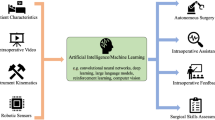Abstract
Background
Laparoscopic suturing skills are important for advanced laparoscopic surgery. However, objective assessment of these skills has not yet been established. The aim of this study was to assess the laparoscopic suturing skills of novice and experienced surgeons using an electromagnetic motion-tracking system.
Methods
A total of 18 surgeons, who were all right-handed, were divided into the following two groups according to their experience as an operator in laparoscopic surgery: 9 novice surgeons (fewer than 10 laparoscopic procedures) and 9 experienced surgeons (more than 50 laparoscopic procedures). The subjects performed an intracorporeal suturing task in an inanimate box laparoscopic trainer while the movements of their forceps were evaluated using an electromagnetic motion-tracking system. Their laparoscopic skills were assessed on the basis of the time, path length, and average speed of the forceps in each hand.
Results
Experienced surgeons completed the suturing task significantly faster than novice surgeons did. The left path length was significantly shorter for experienced surgeons than for novice surgeons, whereas the right path lengths did not differ. The right average speed of knot tying was significantly faster for experienced surgeons than for novice surgeons, whereas the left average speeds did not differ.
Conclusions
Evaluation of psychomotor skills in laparoscopic suturing using an electromagnetic motion-tracking system revealed better results for experienced surgeons than for novice surgeons in terms of the time taken, left path length, and right speed of knot-tying. Furthermore, surgical proficiency due to experience can affect surgical dexterity of each hand differently. The present study also demonstrates the efficacy of this system for objective evaluation of laparoscopic suturing skills.

Similar content being viewed by others
References
Berggren U, Gordh T, Grama D, Haglund U, Rastad J, Arvidsson D (1994) Laparoscopic versus open cholecystectomy: hospitalization, sick leave, analgesia and trauma responses. Br J Surg 81:1362–1365
Aziz O, Constantinides V, Tekkis PP, Athanasiou T, Purkayastha S, Paraskeva P, Darzi AW, Heriot AG (2006) Laparoscopic versus open surgery for rectal cancer: a meta-analysis. Ann Surg Oncol 13:413–424
Rosser JC, Fosser LE, Savalgi RS (1997) Skill acquisition and assessment for laparoscopic surgery. Arch Surg 132:200–204
Smith CD, Farrell TM, McNatt SS, Metreveli RE (2001) Assessing laparoscopic manipulative skills. Am J Surg 181:547–550
Champion JK, Hunter J, Trus T, Laycock W (1996) Teaching basic video skills as an aid in laparoscopic suturing. Surg Endosc 10:23–25
Aggarwal R, Hance J, Undre S, Ratnasothy J, Moorthy K, Chang A, Darzi A (2006) Training junior operative residents in laparoscopic suturing skills is feasible and efficacious. Surgery 139:729–734
Nguyen NT, Mayer KL, Bold RJ, Larson M, Foster S, Ho HS, Wolfe BM (2000) Laparoscopic suturing evaluation among surgical residents. J Surg Res 93:133–136
Cuschieri A, Francis N, Crosby J, Hanna GB (2001) What do master surgeons think of surgical competence and revalidation? Am J Surg 182:110–116
Moorthy K, Munz Y, Dosis A, Bello F, Chang A, Darzi A (2004) Biomodal assessment of laparoscopic suturing skills: construct and concurrent validity. Surg Endosc 18:1608–1612
Datta V, Mackay S, Mandalia M, Darzi A (2001) The use of electromagnetic motion tracking analysis to objectively measure open surgical skill in the laboratory-based model. J Am Coll Surg 193:479–485
Bann S, Kwok KF, Lo CY, Darzi A, Wong J (2003) Objective assessment of technical skills of surgical trainees in Hong Kong. Br J Surg 90:1294–1299
Moorthy K, Munz Y, Dosis A, Bello F, Darzi A (2003) Motion analysis in the training and assessment of minimally invasive surgery. Minim Invasiv Ther 12:137–142
Taffinder N, Smith S, Mair J, Russell R, Darzi A (1999) Can a computer measure surgical precision? Reliability, validity and feasibility of the ICSAD. Surg Endosc 13(suppl 1):81
Smith SG, Torkington J, Brown TJ, Taffinder NJ, Darzi A (2002) Motion analysis. Surg Endosc 16:640–645
Francis NK, Hanna GB, Cuschieri A (2001) Reliability of the advanced Dundee endoscopic psychomotor tester for bimanual tasks. Arch Surg 136:40–43
Francis NK, Hanna GB, Cuschieri A (2002) The performance of master surgeons on the Advanced Dundee Endoscopic Psychomotor Tester: construct validity study. Arch Surg 137:841–844
Emam TA, Hanna G, Cuschieri A (2006) Ergonomic principles of task alignment, visual display and direction of execution of laparoscopic bowel suturing. Surg Endosc 16:267–271
Yamaguchi S, Konishi K, Yasunaga T, Yoshida D, Kinjo N, Kobayashi K, Ieiri S, Okazaki K, Nakashima H, Tanoue K, Maehara Y, Hashizume M (2007) Construct validity for eye–hand coordination skill on a virtual reality laparoscopic surgical simulator. Surg Endosc 21:2253–2257
Dosis A, Aggarwal R, Bello F, Moorthy K, Munz Y, Gillies D, Darzi A (2005) Synchronized video and motion analysis for the assessment of procedures in the operating theater. Arch Surg 140:293–299
Disclosures
Shohei Yamaguchi, Daisuke Yoshida, Hajime Kenmotsu, Takefumi Yasunaga, Kozo Konishi, Satoshi Ieiri, Hideaki Nakashima, Kazuo Tanoue, and Makoto Hashizume have no conflicts of interest or financial ties to disclose.
Author information
Authors and Affiliations
Corresponding author
Rights and permissions
About this article
Cite this article
Yamaguchi, S., Yoshida, D., Kenmotsu, H. et al. Objective assessment of laparoscopic suturing skills using a motion-tracking system. Surg Endosc 25, 771–775 (2011). https://doi.org/10.1007/s00464-010-1251-3
Received:
Accepted:
Published:
Issue Date:
DOI: https://doi.org/10.1007/s00464-010-1251-3




